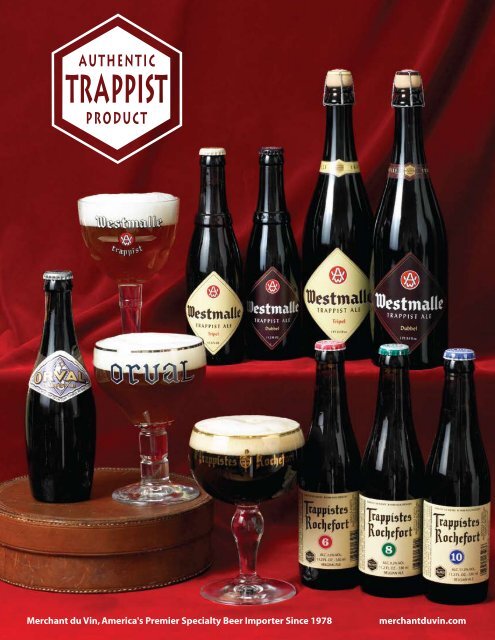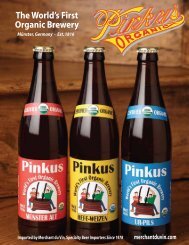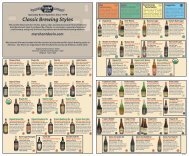MdV Trappist beers product sheet (388 KB .pdf - Merchant du Vin
MdV Trappist beers product sheet (388 KB .pdf - Merchant du Vin
MdV Trappist beers product sheet (388 KB .pdf - Merchant du Vin
You also want an ePaper? Increase the reach of your titles
YUMPU automatically turns print PDFs into web optimized ePapers that Google loves.
<strong>Merchant</strong> <strong>du</strong> <strong>Vin</strong>, America's Premier Specialty Beer Importer Since 1978 merchant<strong>du</strong>vin.com
The <strong>Trappist</strong> Breweries of <strong>Merchant</strong> <strong>du</strong> <strong>Vin</strong><br />
Only <strong>beers</strong> made in a <strong>Trappist</strong> Monastery, under the supervision of the<br />
monks, can use the Authentic <strong>Trappist</strong> Pro<strong>du</strong>ct seal. There are seven<br />
<strong>Trappist</strong> breweries in the world, and the <strong>beers</strong> they pro<strong>du</strong>ce are all<br />
different, but each is a masterpiece of history, dedication . . . and flavor.<br />
Orval - Est. 1070<br />
Orval brews one beer, and brews it to unique perfection. Dry, with a huge<br />
effervescent head, Orval <strong>Trappist</strong> Ale gains some of its character from a complex<br />
fermentation sche<strong>du</strong>le: a Belgian ale yeast is added first for primary fermentation;<br />
then a variety of yeast strains are added midway through the process; finally a<br />
third dose of yeast is added at bottling time. Amber-orange in color,<br />
dry-hopped, and always bottled in the Orval skittle-shaped bottle. 6.9% abv.<br />
In the Orval logo, the trout with the golden ring in its mouth commemorates<br />
Princess Mathilde, who dedicated the grounds for the monastery when, in answer to<br />
her prayers, the trout returned the wedding ring she had dropped into a spring.<br />
Westmalle Dubbel - 11.2 oz bottle<br />
Westmalle Dubbel - 25.4 oz bottle<br />
Westmalle Tripel - 11.2 oz bottle<br />
Westmalle Tripel - 25.4 oz bottle<br />
Westmalle - Est. 1794<br />
In the early days of Belgian brewing, before universal literacy, two "x-marks" on<br />
a cask may have distinguished a "second beer style" made by a monastic<br />
brewery for outside sales, generally stronger than the original variety brewed<br />
for the monks' consumption. Brewing historians think these marks may have<br />
been the root of two current beer styles: <strong>du</strong>bbels (doubles) and tripels (triples).<br />
Dubbels are dark ales of firm strength and body; Westmalle <strong>Trappist</strong> Dubbel<br />
is amber-brown, has notes of caramel, earth and fruit, with a balanced body,<br />
subtle yeast character, and a refined, malty finish. 7.0% abv.<br />
The Abbey of Westmalle that pro<strong>du</strong>ced the first strong, pale-colored tripel (or<br />
triple), in 1934, and today Westmalle <strong>Trappist</strong> Tripel is the benchmark for the<br />
tripel style. It is a glowing golden color, very rich, full-bodied, and elegantly<br />
complex with elusive hints of tropical fruit in the bouquet; firm bitterness and<br />
snappy, aromatic hop finish keep the flavor elements balanced. 9.5% abv.<br />
Rochefort - Est. 1230<br />
The <strong>beers</strong> of Abbaye St-Remy, Rochefort, are packed with extreme flavors but each is<br />
melded into perfect balance. Rochefort 6, sometimes called "Red Cap," has a firm<br />
body with an unrestrained malty flavor and long finish; the bouquet holds fruity<br />
yeast notes that suggest fresh-baked dark bread; 7.5% abv. Rochefort 8, or "Green<br />
Cap," is a full-bodied, rich ale with alcohol at 9.2% abv and compelling flavors of<br />
spice, bittersweet chocolate, figs and leather. Rochefort 10, "Blue Cap," packs<br />
sauvage, incendiary flavors around a bold 11.3 % abv -- notes of earth, fire, port wine,<br />
violets, and possibly tropical fruit, all in cascading layers. The colors range from<br />
brown to deep blackish-brown, and all three have soft red highlights.<br />
The numerical names of the Rochefort <strong>beers</strong> - "6," "8," and "10" - come from "Belgian<br />
degrees," a traditional, historical means of measuring gravity (or, the sweetness of<br />
the wort before fermentation) and determining the final strength of the beer.<br />
Orval - 11.2 oz bottle<br />
Rochefort 6 - 11.2 oz bottle<br />
Rochefort 8 - 11.2 oz bottle<br />
Rochefort 10 - 11.2 oz bottle<br />
merchant<strong>du</strong>vin.com<br />
<strong>Merchant</strong> <strong>du</strong> <strong>Vin</strong>, America's Premier Specialty Beer Importer Since 1978




